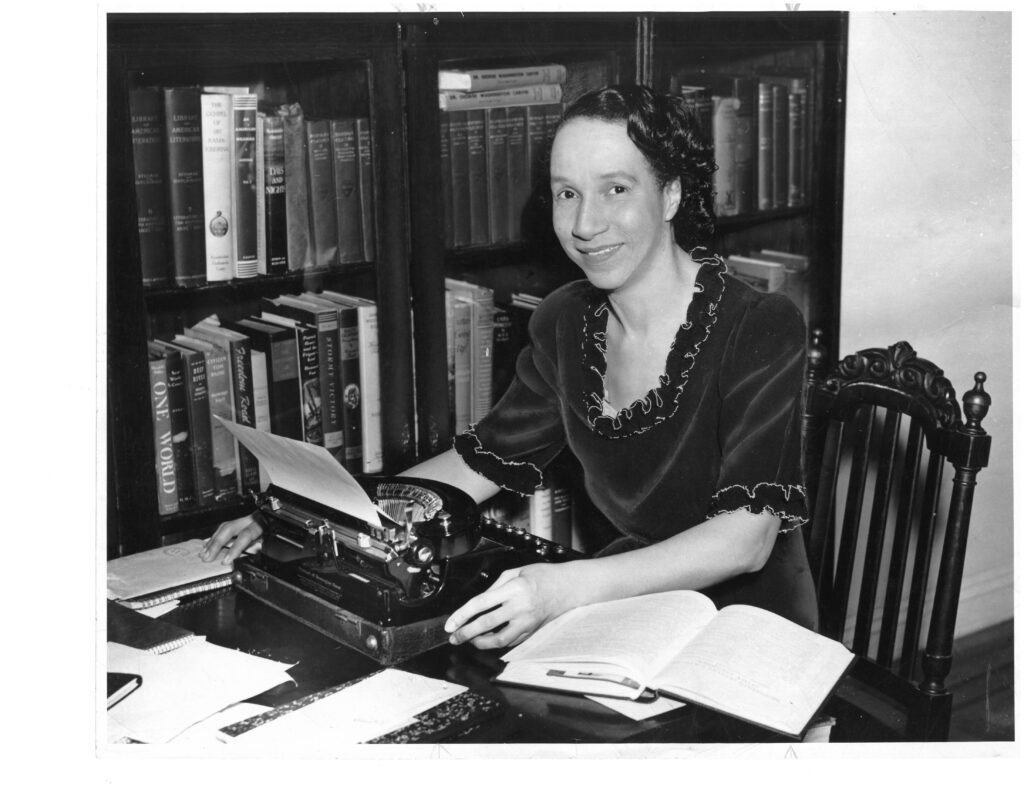
Author Shirley Graham Du Bois (Courtesy Oberlin College Archives)
The last two times I taught African Americans and Children’s Literature I went out of my way to teach a book by Shirley Graham Du Bois (born November 11, 1896). There were three reasons for this:
First, I wanted students to understand that children’s literature was more than fiction and poetry, that non-fiction works were a major portion of the corpus. Some of the chapter books I most vividly remember from my childhood were a series of blue-covered children’s biographies of such figures as Robert Fulton, “Mad” Anthony Wayne, Abraham Lincoln, and George Washington. They were perhaps 120 pages long with spot illustrations. I cannot say I liked these books, as I surely preferred fiction as a child. I was mostly forced to read them by either my sisters or by teachers, who seemed invested in the idea that I had to learn to read books I had to read, rather than simply books I wanted to read. I have never forgotten these small biographies. I can still recall passages from them, even how the books smelled.
Second, Shirley Graham Du Bois’s children’s books are, for the most part, out-of-print. They are not receiving the attention they deserve and are not likely to have been read by my students when they were younger. In short, I am sure she was completely unknown to them, and so I was doing them a favor by introducing them to her work.
Third, I wanted the students to see a connection between Shirley Graham and her second husband, W. E. B. Du Bois. The intellectual activist and editor of NAACP’s house organ, The Crisis, Du Bois started in 1920 what is believed to be the first Black children’s magazine in the United States, The Brownies’ Book, which lasted two years. His wife Shirley Graham’s efforts to create a kind of Black historical mythology with her children’s biographies of significant Black historical figures began in 1944, with the publication of her book Dr. George Washington Carver, Scientist. It felt a bit, pedagogically, as if I were closing a circle.
(I closed a circle in another way in the course by teaching South Town, a hard-hitting, pioneering, 1958 children’s novel about Black life and racism in the south by Shirley’s brother, Lorenz B. Graham. She taught him to read so well that when he started school at the age of six, he was placed in the second grade.)
The two Shirley Graham Du Bois books I taught were Your Most Humble Servant, Benjamin Banneker (1949), about the biracial colonial American clock and almanac maker, and Julius K. Nyerere, Teacher of Africa (1975), about the noted African leader and founding president of Tanzania. The books are complementary, of course: the first offering her view of aspects of the American founding and the latter her view of African independence and nation-building. She knew Nyerere (in fact, became a citizen of Tanzania after having to depart from Ghana when Kwame Nkrumah was deposed), mentioning that fact in the book, and so this biography demonstrates a kind of immediacy that the other lacks, but both have an intimacy that may well strike a child as, well, for lack of a better word, pure. She also wrote biographies of Paul Robeson, Frederick Douglass, Booker T. Washington, and Abdul Gamal Nasser. (She lived in Cairo for a time and had met Nasser.) I think the students struggled a bit with the Banneker biography as it was surprisingly long and a bit complex, for Banneker’s personality is a challenge to convey to a child, the dreamer. On the whole, the Nyerere biography, shorter and more “modern,” was better received. Nyerere was a sort of George Washington of Africa and this sort of hero is easier for a child to understand. She wanted more books about Blacks available for Black children to combat their flagrant miseducation about themselves and decided to start writing them herself. If the blue-covered children’s biographies I read as a boy were meant to make me American, patriotic, a believer in the Redeemer Nation, Du Bois’s biographies were trying to give Black children a truer sense of themselves as Black and American, and Black and members of a Diaspora, to make them believers in another type of Redeemer nationalism.

What is surprising is that she wrote children’s books at all. Graham Du Bois was a musician and composer, and her first artistic works were musicals and operas. She had little success as a composer and turned to literature, finding her true calling in writing for children or at least a calling more likely to put bread on the table for a talented woman with few other outlets for her creativity. It was acceptable for smart women to write children’s books because children’s books were not considered, in most literary circles, to be important literature. In hindsight, her biographies have more significance than many adult books of her era.
She married W. E. B. Du Bois in 1951 when she was 54 and he was 83. (“Love is lovelier the second time around,” as the Van Heusen and Cahn song goes, as both had been married previously.) Both were communists. Both had had long careers as activists when they met. They emigrated to Ghana in 1958 where they became citizens. They did not want the United States and the United States did not want them. She also spent considerable time in China during the days of the Cultural Revolution. On this Veterans’ Day, Shirley Graham Du Bois might be remembered in her own right as a veteran of some important battles in a long war.
